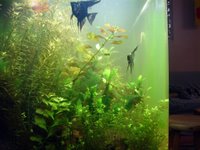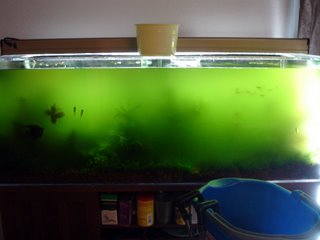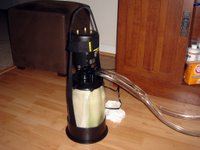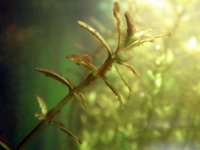Algae Gallery
 "green water" algae
"green water" algaeFor a mild case, the green water is not colored green, it is more of a neutral cloudy color. If the algae becomes more concentrated, the green color will become more visible. You can tell it is green water as opposed to a bacteria outbreak if you can see that it grows worse over the course of the day and becomes better after the night.
For me, green water is triggered when I uproot plants/stir up gravel and trim the existing plants back severely. A popular theory is that stirring up gravel may release ammonia from decaying plant matter into the water, triggering a growth of green water algae. Stirring up the ammonia, combined with a severe pruning of plants that would otherwise soak up the ammonia, creates a double whammy that greatly increases the probability of a green water algae explosion. Once the algae has grown to sufficient numbers, it seems to enjoy the same nutrient/light/CO2 parameters as your plants and will happily coexist with the plants, even after the initial ammonia supply has been depleted.
If the green water is advanced, you cannot "starve" it to death by minimizing nutrients. Minimizing phosphates/nitrates do not work to starve green water. I have observed that both dosing and starving phosphates and nitrates do not seem to have much effect on green water. On the other hand, though, I have observed that dosing micro nutrients (e.g. Flourish or TMG or PMDD) and/or iron seems to slightly encourage the growth of green water, if the green water already exists.
If the case of green water is mild enough (e.g. slight haze to water), then you can successfully eradicate it if you can increase the rate of plant growth and/or increase the number of fast growing plants. Don't be afraid to dose sufficient levels of nitrates/phosphates/potassium. They will not make the green water worse and will help encourage plant growth. I had slightly hazy water in a tank with 2 watts/gallon lighting, and when I added an extra watt/gallon (with sufficient nutrients and CO2), the boost in lighting encouraged plant growth such that the day after adding the extra lighting, the haze simply disappeared. Of course, if you have high lighting but have a bottleneck elsewhere, such as insufficient nutrients or CO2, then again, you will not be maximizing plant growth, and green water will take advantage of the opportunity and persist.
 If the case of green water is severe enough (e.g. tank looks like pea soup), then the green water will block light and/or take up nutrients to the extent that plant growth will slow down even further, until you will no longer be able to use plant growth to outcompete the green water. Water changes will not be successful. There will always remain enough of the green water such that it will simply bounce back. You must completely eradicate the green water through other means.
If the case of green water is severe enough (e.g. tank looks like pea soup), then the green water will block light and/or take up nutrients to the extent that plant growth will slow down even further, until you will no longer be able to use plant growth to outcompete the green water. Water changes will not be successful. There will always remain enough of the green water such that it will simply bounce back. You must completely eradicate the green water through other means.Although I have not personally tried this method, blacking out the tank for several days is probably one good (and cheap) option to try to kill the green water. I have observed that the population of green water definitely decreases after each night, and so a blackout of multiple days should work to kill green water. I am guessing, though, that the problem with this method is that you must ensure that the green water is completely gone during the blackout, or else it will simply grow back, especially since you will also be slowing down plant growth with the same blackout.
Although I have not personally tried this method either, adding daphnia to your tank (separated from your hungry fish by some sort of partition/fine netting) is also said to work to remove green water by having the daphnia feed upon the algae.
 Diatom filters work by manually filtering out the green water algae from the water. I have used the Vortex XL diatom filter. You must make sure, though, that the filtering grade of the diatomaceous earth (DE) is fine enough to filter out the free floating algae. I had initally used a DE brand that was not fine enough (it was called "All-Clear"), so that the diatom filter ran for hours without filtering out the algae. Also, you must run the diatom filter for a long enough period so that it removes as much of the algae as possible. I ran it till the water was crystal clear, and then kept it running for a couple hours longer. Again, I think it is very important to get the population of the green water algae as low as you possibly can in order to help prevent it from growing back.
Diatom filters work by manually filtering out the green water algae from the water. I have used the Vortex XL diatom filter. You must make sure, though, that the filtering grade of the diatomaceous earth (DE) is fine enough to filter out the free floating algae. I had initally used a DE brand that was not fine enough (it was called "All-Clear"), so that the diatom filter ran for hours without filtering out the algae. Also, you must run the diatom filter for a long enough period so that it removes as much of the algae as possible. I ran it till the water was crystal clear, and then kept it running for a couple hours longer. Again, I think it is very important to get the population of the green water algae as low as you possibly can in order to help prevent it from growing back.For me, though, running the diatom filter is a hassle, in terms priming and charging the filter bag with DE. A lot of this hassle, though, is related to the design of the Vortex brand. Another brand called System 1 is designed to be self-priming and is much easier to charge, but it didn't fit over the wide lip of my acrylic tank (glass tanks will be fine), so I couldn't use it.
When doing water changes, it seems to help at least a little bit to vacuum up as much of debris/plant mulm as possible from the gravel.
Although I don't know if this had any effect, after a water change, I would also add a dose of bacteria starter. At least it doesn't hurt. In the same vein, you may also consider adding more biological filter media to your filters in order to encourage more growth of ammonia consuming bacteria.
Notes on using a UV sterilizer coming soon...
After manually removing/killing the green water, you must then focus on carefully encouraging the growth of plants and/or increase the number of plants in order to prevent a comeback. This means making sure you have sufficient macro nutrients and CO2 relative to your lighting. I avoid dosing iron/micros for the first couple days after clearing out green water in order to lessen the probability that the green water immediately grows back while the plants are still recovering. You may need to repeat the treatment (e.g. running the diatom filter a second time a week later) while you wait for the plants to fully recover.
For those who insist on seeing the silver lining in green water, one beneficial side effect of a severe case of green water is that it also seems to reduce other existing algae.
 brown sludge (diatom?) algae
brown sludge (diatom?) algaeI nicknamed this the "brown sludge" algae, since this seems different from the normal brown diatom algae I've seen in tanks that are newly set up. Here are its characteristics:
- It sits in little piles on top of the plant leaves, but otherwise does not seem to particularly attach to any plants or gravel. It does not have any threads or filaments.
- The brown sludge blows off easily. Stirring the water currents will easily blow it off the leaves of the plants.
- It has a goopy, slimy brown appearance that is shaped in brown droplets when suspended in the water. In this way, it seems to differ in appearance from brown diatom algae, which is usually a little coarser in appearance and more clumpy.
- It disappears by morning but grows back over the course of the day.
- It seems worse right after a water change.
 Unknown green algae. ID anyone?
Unknown green algae. ID anyone?- It does not seem filamentous.
- It is bright green.
- It does not smell bad or feel too slimy (ie probably not cyanobacteria).
- When it grows thick enough, you can peel it off the leaf in a sheet.
- If the layer of algae is thick enough, when you press it between your fingers, it feels like mini bubble wrap, like you are popping small bubbles.
- It grows at a moderate rate, grows back within several days.
- It grows discretely on a leaf, meaning it doesn't form "cobwebs" or span across multiple leaves in a single sheet.


1 Comments:
the algae is called the blue-green algae and can be very dangerous for both, plants and the fish. Very nice aquarium you have.
By Dusko Bojic aka Che Guebuddha, at 10:41 AM
Dusko Bojic aka Che Guebuddha, at 10:41 AM
Post a Comment
<< Home